Ian Fleming’s Novel ‘Casino Royale’ Introduced James Bond 70 Years Ago
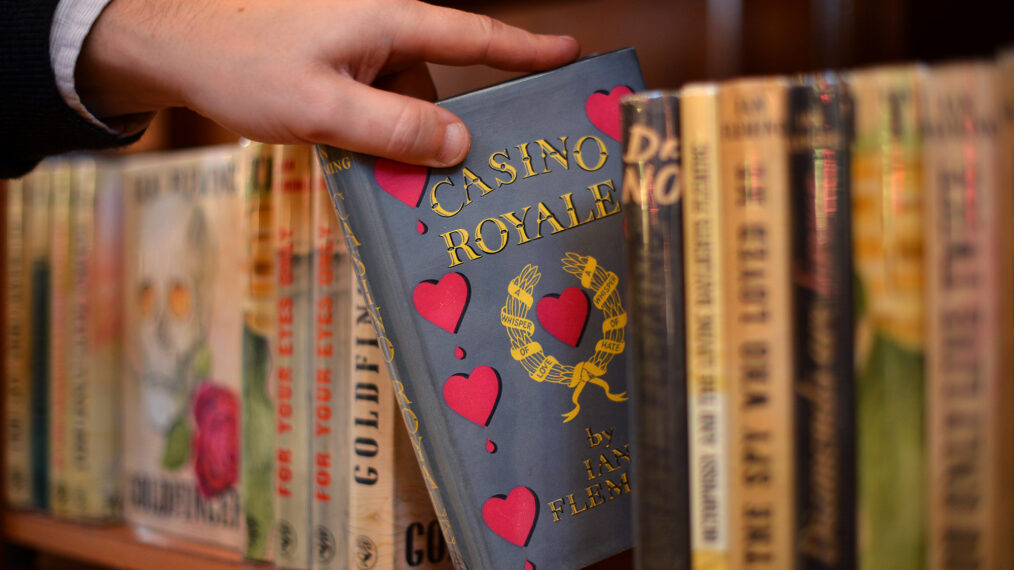
On April 13, 1953, Ian Fleming‘s Casino Royale — the British author’s first novel overall, as well as the first in his James Bond series of spy thrillers — was published in the U.K. in a hardcover edition.
The novel opens in a similar way to how the later films based on the soon-to-be iconic character of 007 have, by thrusting the reader right into a tense and dangerous scenario.
Except here, it is Fleming’s words, rather than images and sounds, that are used to brilliantly conjure the scene in the mind’s eye:
Chapter 1: The Secret Agent
“The scent and smoke and sweat of a casino are nauseating at three in the morning. Then the soul-erosion by high gambling—a compost of greed and fear and nervous tension—becomes unbearable, and the senses awake and revolt from it.
“James Bond suddenly knew that he was tired. He always knew when his body or his mind had had enough, and he always acted on the knowledge. This helped him to avoid staleness and the sensual bluntness that breeds mistakes.” (from the July 1990 tenth Berkley printing of Casino Royale, page 1; © 1953 Gildrose Productions Ltd.)
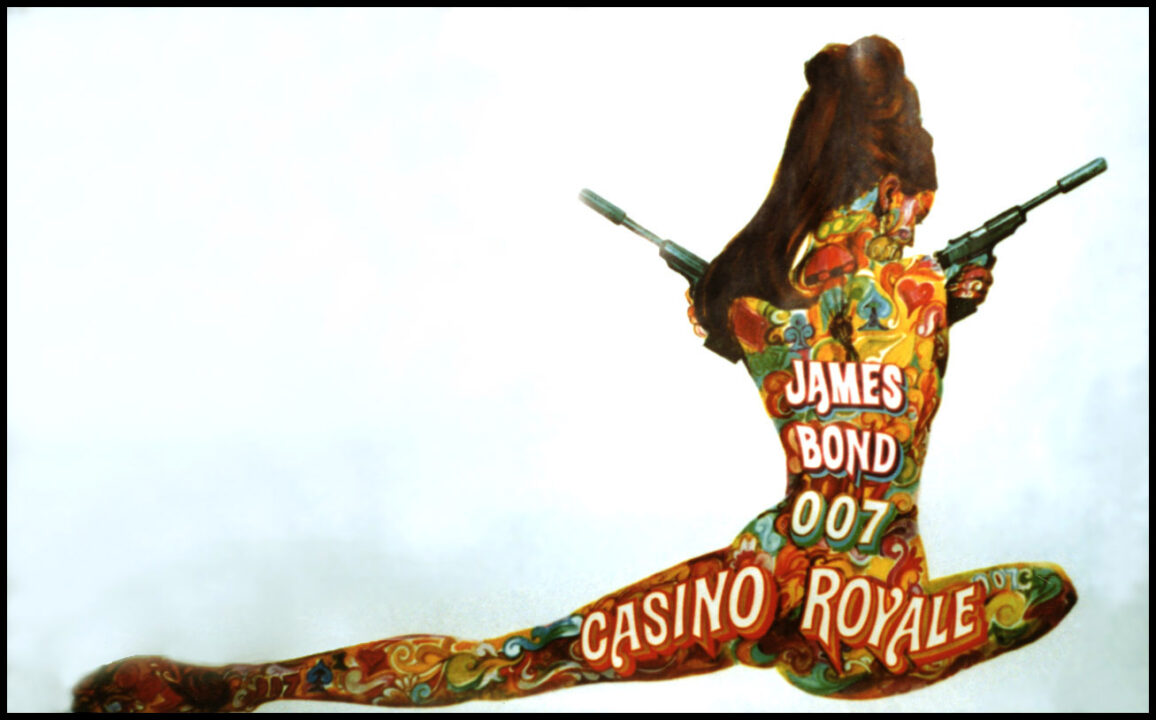
Image from the poster art for the 1967 film Casino Royale, which was the second live-action adaptation of Ian Fleming’s first James Bond novel
The thrillingly terrific descriptors in these passages instantly place the reader into a situation by now familiar to fans of 007: a glamorous casino.
But Fleming makes it sound anything but glamorous once you get past its external appearance, and imparts the underlying danger lurking there. Similarly, the second paragraph offers a level of deeper insight into the mind of the then-unfamiliar secret agent James Bond, beyond what looks like a suave, carefree exterior. Right off the bat, it’s a presentation of Bond in a way not often explored in the films based on Fleming’s works made over the past seven decades that are likely more familiar to people than the books at this point.
And that sort of realism continues throughout Casino Royale, which sets up most of the by-now familiar staples of his universe: Bond himself; M; Moneypenny; a villain, in this case, Le Chiffre, and his henchmen; a “Bond girl,” Vesper Lynd, the first and one of the most memorable of this character type; Bond’s occasional American ally, CIA agent Felix Leiter; casinos in general, which have long been familiar settings for at least some Bond action and the game of baccarat specifically (baccarat is often 007’s game of choice in the novels and films); and lots of cocktails, including “The Vesper,” a drink invented by Bond in the book and named after the woman who briefly captured his heart.
Casino Royale finds Bond taking on Le Chiffre, purser for a trade union controlled by the Soviet counterintelligence agency SMERSH, at the titular French casino. Le Chiffre has lost a considerable amount of his ruthless clients’ money and hopes to win it back in a high-stakes baccarat game. Bond is tasked with going undercover and bankrupting him, and the union, at the table, using his baccarat skills.
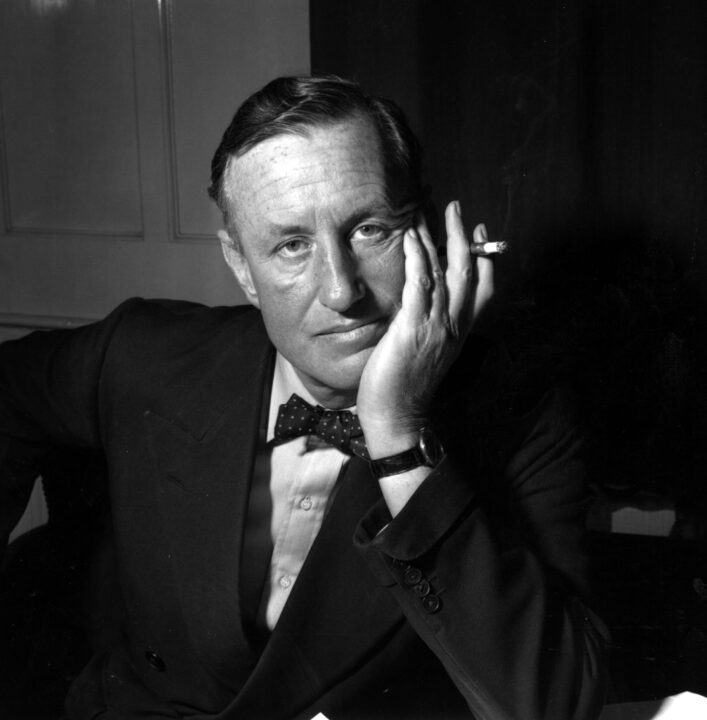
Ian Fleming, looking a bit James Bond-like in a 1958 photo. (Express Newspapers/Getty Images)
Using a combination of his real-life World War II experiences working for Britain’s Naval Intelligence Division as well as his formidable imagination, Fleming crafted a thrilling tale that remains one of the finer of his Bond novels. It was immediately popular upon its U.K. release; it took a little longer to catch on in America when it was published there nearly a year later, in March 1954.
Fleming’s works did become popular in America, of course, especially with the advent of the Sean Connery-led big-screen adaptations that began with Dr. No in 1962. Earlier, in 1961, President John F. Kennedy had shouted out Fleming’s 1957 Bond novel From Russia With Love as one of his 10 favorite books, which certainly helped fuel the Fleming fire.
After Casino Royale, the author published 11 more 007 novels, and two collections of short stories featuring the secret agent, before his passing in 1964 (two books — the novel The Man with the Golden Gun and the collection Octopussy and The Living Daylights — were published posthumously, in 1965 and 1966, respectively).
Casino Royale and Fleming’s Other Bond Stories Get a New Look (And Lookover)
Beginning April 13, 2023, on the 70th anniversary of Casino Royale‘s U.K. release, Ian Fleming Publications Ltd. — the author’s literary estate and now publishers — is making that novel and all of Fleming’s Bond works available with new U.K. editions featuring new-look covers.
Along with the new covers, some of the books have been reviewed, and a few changes that are “very small in number,” according to the publisher, have been made to the original text, particularly the use of racial words that were problematic even at the original time of publication. Some books, including Casino Royale, remain unaltered. More info on this can be read in Ian Fleming Publications’ statement at this link.
In terms of the books’ new covers, here is what the cover of Casino Royale‘s new U.K. release looks like:
View this post on Instagram
It’s unclear yet if American publications of the books will have the same or different covers. But interested readers can check out all of the new covers, and purchasing options for U.S. buyers, at this link.
Beyond the Book: Casino Royale Live-Action Adaptations
Climax!: “Casino Royale” (1954 TV episode)
This perhaps little-known, and certainly little-seen today, episode of the CBS anthology drama series Climax!, which ran four seasons from 1954-58, featured the first live-adaptation of the first James Bond novel as the third episode of its first season, on Oct. 21, 1954.
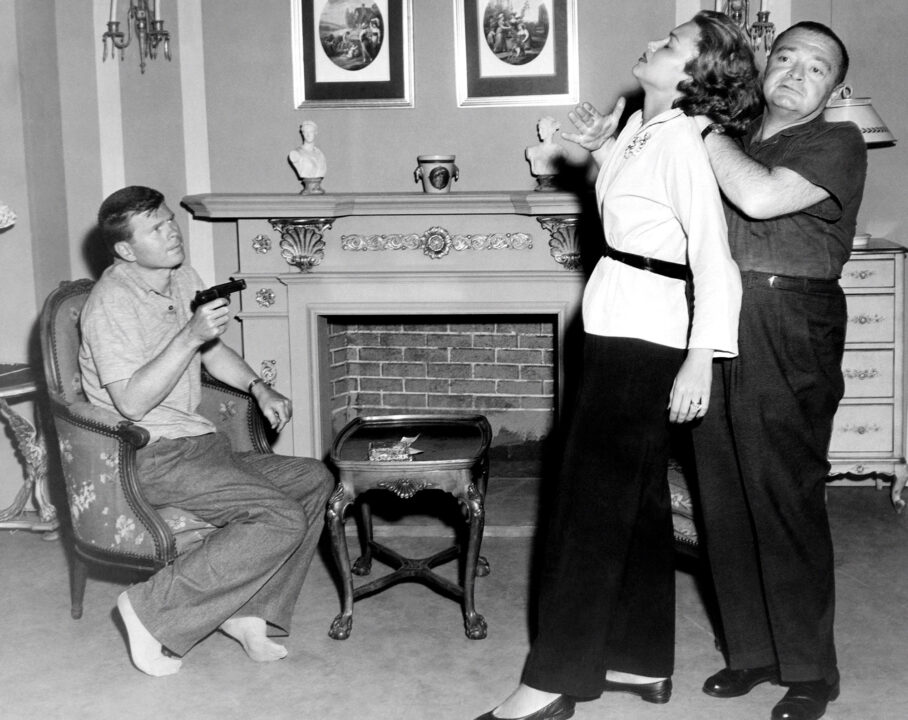
(l-r) Barry Nelson as James Bond, Linda Christian as Valerie Mathis and Peter Lorre as Le Chiffre in the first adaptation of Casino Royale, which originally aired live October 21, 1954, on the Climax! anthology series (Courtesy Everett Collection)
While there are some elements of what we now expect to recognize in a spy thriller, and especially in a Bond production, this hourlong presentation isn’t quite there in total. But it can be excused given that it was venturing into different territory, trying to bring a new type of espionage tale to American audiences who were perhaps more familiar with film noir detective stories, which this production sometimes resembles. As such, the story flip-flops or removes some elements from the novel; maybe, in the producers’ estimation, to make it more palatable to U.S. audiences? Did they think those audiences weren’t ready to see a Brit as the main hero, and an American character as merely his helper?
In the most blatant change, James Bond here (sometimes referred to as “Jimmy”) is an American operative working for the “Combined Intelligence Agency,” played by Barry Nelson. Linda Christian costars as the Bond girl here, but her character is called Valerie Mathis, an amalgam of the novel’s Vesper Lynd and René Mathis, a French contact who aided 007. The Leiter in this story is known as Clarence Leiter, a British agent! (played by Michael Pate). Le Chiffre remains relatively unchanged, and in the form of legendary villain-portrayer Peter Lorre.
What also makes this episode feel a little clunky is the fact that it was originally produced live, but I do have to give it big props for that effort. There are some cool stage effects right off the bat as Bond is shot at while just trying to enter the casino. That incident also leads to one of the first of the witty Bond quips that became a staple in the subsequent big-screen features: After Leiter asks Bond, “Aren’t you the fellow who was shot?” Bond responds with, “No, I’m the fellow who was missed.”
While not the thrill ride we’ve come to expect from live-action James Bond adaptations, this Climax! production of Casino Royale makes for intriguing viewing from a historical standpoint, if for no other reason:
Casino Royale (1967 movie)
A lot more familiar to most people is this second live-action adaptation of Casino Royale, released in April 1967 and during an era when theaters were filled with various straight-out spy films and parodies of the genre hoping to capitalize on the success of the James Bond franchise from Albert R. Broccoli and Harry Saltzman‘s Eon Productions starring Connery. Its debut came two months before the premiere of You Only Live Twice, which was Eon’s fifth Bond film in five years and Connery’s second-to-last “official” appearance as 007 in an Eon movie.
Eon did not have the rights to Casino Royale at the time; this was produced by Columbia. The producers opted to make it a spoof of Bond movies and other spy films as a whole, likely because they knew they couldn’t erase Connery from the character in the minds of audiences at the time (some people even today probably have trouble seeing anyone else as Bond), and maybe because they saw that the 007 franchise, while still quite popular, was not at the heights it had been around the time of Goldfinger in 1964, with even Connery starting to tire of it.
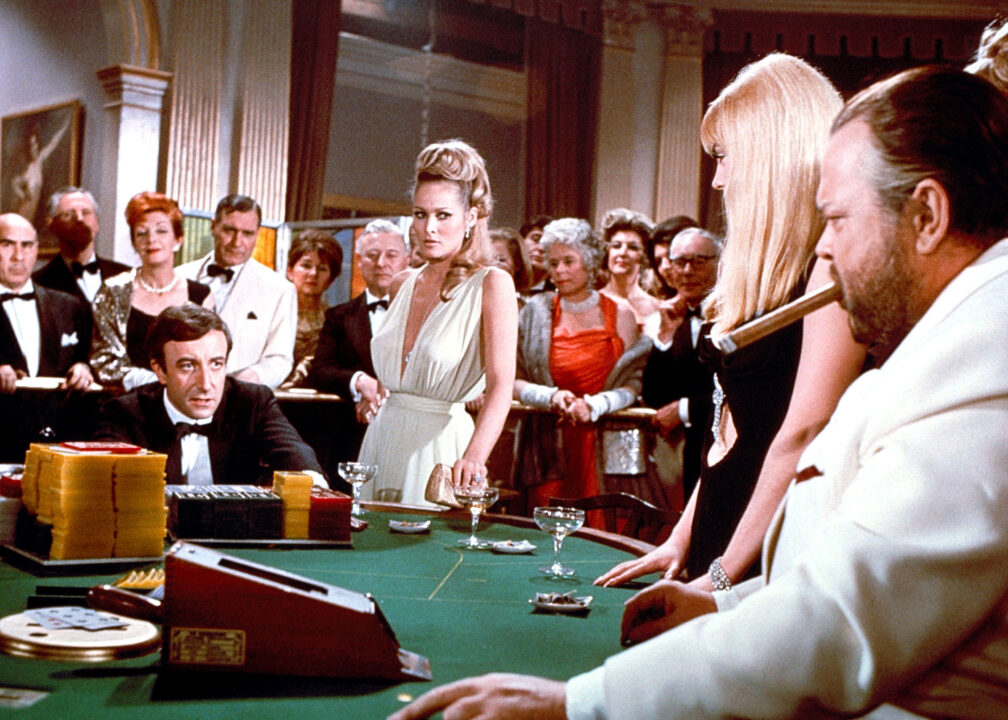
(l-r) Peter Sellers, Ursula Andress and Orson Welles in 1967’s Casino Royale (Courtesy Everett Collection)
So, this Casino Royale was a comedy, and probably stood out all the more because of that at the time of its release, as the only spoof to be able to use official names and scenarios from a Fleming novel. That is likely a big part of why it is remembered and beloved today, as opposed to if it had been an action-oriented 007 wannabe.
It took a whopping five directors, including John Huston and Val Guest, to bring this Casino Royale to the screen, and frankly, it’s still a bit of a mess at times, but it looks great and is a lot of fun.
Playing among the film’s very colorful, and often psychedelic surroundings is a terrific cast featuring David Niven as Sir James Bond 007, the “original” Bond; Peter Sellers as baccarat master Evelyn Tremble, one of the many numerous agents who are dubbed “James Bond 007” in an attempt to confuse SMERSH; Ursula Andress, who memorably played the first Eon Bond girl, Honey Ryder, in Dr. No, as Vesper Lynd (also an agent referred to as “James Bond”); Orson Welles as Le Chiffre; Woody Allen as Dr. Noah (aka Sir James’ nephew, Jimmy Bond, who has defected to SMERSH); and many more.
One of the enduring legacies of this film was its introduction of Burt Bacharach and Hal David‘s Oscar-nominated song “The Look of Love,” performed by Dusty Springfield. That song is among the numerous elements of this Casino Royale that clearly served as an inspiration for Mike Myers‘ Austin Powers comedies 30 years later.
Casino Royale (2006 movie)
Eon Productions was finally able to make its own adaptation of Casino Royale for the official James Bond film franchise nearly 40 years after the Columbia-produced comedy, and it was worth the wait. The first Bond entry starring Daniel Craig as 007 is not only his best, but one of the best overall in the Bond franchise. It costarred a terrific cast, including Eva Green as Vesper, Mads Mikkelsen as Le Chiffre, Jeffrey Wright as Leiter, Giancarlo Giannini as Mathis and Judi Dench as M.
The film is a worthy adaptation of Fleming’s novel, maintaining a lot of its key elements (while updating some, notably the changing of the card game from baccarat to the more currently popular No Limit Texas hold em poker). It also helped bring the famed secret agent fully into the 21st century with brute force, breathless action sequences, wit and humanity — one of the few Bond adaptations that lets us get somewhat inside this “blunt instrument” in a way that the opening passage of Fleming’s novel did seven decades ago. It includes an especially fascinating portion of the book’s insight into Bond’s psyche, where even the ultra-manly spy has internal worries about being able to “perform” sexually with Vesper following his brutal torture at the hands of Le Chiffre.
One aspect where this movie improves upon the book is in its final portion, which adds thrilling and poignant drama to the scenes following all the action of Bond trying to outwit Le Chiffre at the card game; the post-casino plot and ending is one area where Fleming’s book feels a little tacked on and padded-out.
Oh, on top of that, this Casino Royale has one of the most memorable title songs and opening credits sequences in the franchise:
